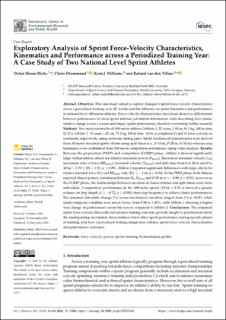| dc.identifier.citation | Hicks, D. S., Drummond, C., Williams, K. J. & van den Tillaar, R. (2022). Exploratory analysis of sprint force-velocity characteristics, kinematics and performance across a periodized training year: A case study of two national level sprint athletes. International Journal of Environmental Research and Public Health, 19(22), Article 15404. doi: | en_US |
| dc.description.abstract | Objective: This case study aimed to explore changes to sprint force-velocity characteristics across a periodized training year (45 weeks) and the influence on sprint kinematics and performance in national level 100-meter athletes. Force-velocity characteristics have been shown to differentiate between performance levels in sprint athletes, yet limited information exists describing how characteristics change across a season and impact sprint performance, therefore warranting further research. Methods: Two male national level 100-meter athletes (Athlete 1: 22 years, 1.83 m, 81.1 kg, 100 m time: 10.47 s; Athlete 2: 19 years, 1.82 cm, 75.3 kg, 100 m time: 10.81 s) completed 12 and 11 force-velocity assessments, respectively, using electronic timing gates. Sprint mechanical characteristics were derived from 30-meter maximal sprint efforts using split times (i.e., 0–10 m, 0–20 m, 0–30 m) whereas step kinematics were established from 100-meter competition performance using video analysis. Results: Between the preparation (PREP) and competition (COMP) phase, Athlete 1 showed significantly large within-athlete effects for relative maximal power (PMAX), theoretical maximal velocity (v0), maximum ratio of force (RFMAX), maximal velocity (VMAX), and split time from 0 to 20 m and 0 to 30 m (−1.70 ≤ ES ≥ 1.92, p ≤ 0.05). Athlete 2 reported significant differences with large effects for relative maximal force (F0) and RFMAX only (ES: ≤ −1.46, p ≤ 0.04). In the PREP phase, both athletes reported almost perfect correlations between F0, PMAX and 0–20 m (r = −0.99, p ≤ 0.01), however in the COMP phase, the relationships between mechanical characteristics and split times were more individual. Competition performance in the 100-meter sprint (10.64 ± 0.24 s) showed a greater reliance on step length (r ≥ −0.72, p ≤ 0.001) than step frequency to achieve faster performances. The minimal detectable change (%) across mechanical variables ranged from 1.3 to 10.0% while spatio-temporal variables were much lower, from 0.94 to 1.48%, with Athlete 1 showing a higher ‘true change’ in performance across the season compared to Athlete 2. Conclusions: The estimated sprint force-velocity data collected across a training year may provide insight to practitioners about the underpinning mechanical characteristics which affect sprint performance during specific phases of training, plus how a periodized training design may enhance sprint force-velocity characteristics and performance outcomes. | en_US |

